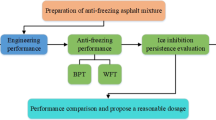Abstract
Because of its excellent ability to melt ice, numerous studies have praised anti-freezing asphalt concrete (AFAC) as a potential replacement for deicing agents. In this paper, we studied the ice-disbonding ability of AFAC from a mechanical perspective. Firstly, the interfacial adhesion mechanism between ice and pavement was discussed based on the quasi-liquid layer (QLL) theory, and the factors influencing ice–pavement adhesion strength were analyzed accordingly. Thereafter, ice-adhesion strength was studied both vertically and horizontally using mechanical tests conducted at the ice–pavement adhesion interface. The findings showed that the AFAC weakened the ice-adhesion strength significantly by up to 80%. Further, the magnitude and characteristics of the effect varied considerably depending upon temperature and the amount added. Finally, AFAC’s long-term ice-adhesion characteristics were determined using washing-drying cycles that simulated environmental effects. The results showed that the washing-drying cycles increased ice-adhesion strength significantly, especially at temperatures between 0 and 5 °C. The ice-adhesion model based on QLL theory accounted well for the results, which showed variable trends in ice-adhesion strength. However, because the break characteristics varied at different temperatures, the exact value of ice-adhesion strength cannot yet be forecasted accurately. By studying the ice–pavement adhesion interface from a mechanical perspective, this paper may provide some fresh insights for current studies of AFAC.















Similar content being viewed by others
References
Tokunaga R, Kiriishi M, Takahashi N (2013) A study on the use of quantitative indicators for winter road performance measurement and evaluation in Japan. In: International symposium on cold regions development. Anchorage, pp 355–366
Eskandarian A et al (2005) The government approach to improving vehicle/highway transportation safety and its effectiveness. In: First international conference on traffic accidents. University of Tehran, Iran
Shi X et al (2009) Corrosion of deicers to metals in transportation infrastructure: introduction and recent developments. Corros Rev 27(1–2):23–52
Fay L, Shi X (2012) Environmental impacts of chemicals for snow and ice control: state of the knowledge. Water Air Soil Pollut 223(5):2751–2770
Wright M, Parry T, Airey G (2016) Chemical pavement modifications to reduce ice adhesion. In: Proceedings of the institution of civil engineers-transport. Institution of Civil Engineers, pp 76–87
Farnam Y et al (2015) Evaluating the use of phase change materials in concrete pavement to melt ice and snow. J Mater Civ Eng 28(4):04015161-1–04015161-10
Gao J et al (2017) Utilization of steel slag as aggregate in asphalt mixtures for microwave deicing. J Clean Prod 152:429–442
Liu X, Wu S (2011) Study on the graphite and carbon fiber modified asphalt concrete. Constr Build Mater 25:1087
Liu X, Wu S (2009) Research on the conductive asphalt concrete’s piezoresistivity effect and its mechanism. Constr Build Mater 23:2752–2756
Wu D et al (2010) The anti-icing mechanism of rubber asphalt pavement. In ICCTP, pp 3918–3926
Stroup-Gardiner M (2008) Use of verglimit deicing product on El Dorado county highway 50 PM 38.6–39.7
Liu Z et al (2015) Low temperature property and salt releasing characteristics of antifreeze asphalt concrete under static and dynamic conditions. Cold Reg Sci Technol 114:9–14
Giuliani F et al (2012) Effectiveness of sodium chloride-based anti-icing filler in asphalt mixtures. Constr Build Mater 30:174–179
Zheng M et al (2015) Evaluation of long-term performance of anti-icing asphalt pavement. Constr Build Mater 84:277–283
Dan H-C et al (2014) Laboratory study on the adhesive properties of ice to the asphalt pavement of highway. Cold Reg Sci Technol 104–105:7–13
Liu Z et al (2014) Influence of the chloride-based anti-freeze filler on the properties of asphalt mixtures. Constr Build Mater 51:133–140
Flintsch G et al (2003) Pavement surface macrotexture measurement and applications, in transportation research record. J Trans Res Board 1860(1):168–177
MoTPRC (2012) Standard test methods of bitumen and bituminous mixtures for highway engineering. China Communications Press, Bei**g, pp 301–303
Gilpin RR (1979) A model of the “liquid-like” layer between ice and a substrate with applications to wire regelation and particle migration. J Colloid Interface Sci 68(2):235–251
Jellinek HHG (1967) Liquid-like (transition) layer on ice. J Colloid Interface Sci 25(2):192–205
Jellinek HHG (1959) Adhesive properties of ice. J Colloid Sci 14(3):268–280
Cai S, Bhushan B (2008) Meniscus and viscous forces during separation of hydrophilic and hydrophobic surfaces with liquid-mediated contacts. Mater Sci Eng R: Rep 61(1):78–106
Jellinek HHG (1962) Ice adhesion. Can J Phys 40(10):1294–1309
Döppenschmidt A, Butt H-J (2000) Measuring the thickness of the liquid-like layer on ice surfaces with atomic force microscopy. Langmuir 16(16):6709–6714
Du Y et al (2016) Inhibition and removal of thin ice on the surface of asphalt pavements by hydrophobic method. J Test Eval 44(2):711–718
Adl-Zarrabi B, Mirzanamadi R, Johnsson J (2016) Hydronic pavement heating for sustainable ice-free roads. Trans Res Procedia 14:704–713
Weissenborn PK, Pugh RJ (1996) Surface tension of aqueous solutions of electrolytes: relationship with ion hydration, oxygen solubility, and bubble coalescence. J Colloid Interface Sci 184(2):550–563
Penn LS, Meyerson A (1992) Ice-pavement bond prevention: fundamental study. National Research Council, Washington, DC, pp 5–12
Wuori AF (1993) Ice-pavement bond disbonding: surface modification and disbonding. National Research Council, Washington, DC, pp 3–14
Guerin F et al (2016) Analytical model based on experimental data of centrifuge ice adhesion tests with different substrates. Cold Reg Sci Technol 121:93–99
Li F, Wang Z (2012) Experiment on road performance of asphalt mixture with automatic long-term snowmelt agent. J Highw Trans Res Dev 6(4):11–17
Acknowledgements
This project was supported by Outstanding Youth Fund, Chang'an University (No. 310831163501), Transportation Construction & Technology Project, Shanxi Department of Transportation (No. 16-2-12), Natural Science Basic Research Plan in Shaanxi Province of China (No. 2017JQ2025), and Transportation Technology Project, Qinghai Department of Transportation (No. 2014-01).
Author information
Authors and Affiliations
Corresponding author
Rights and permissions
About this article
Cite this article
Chen, H., Wu, Y., **a, H. et al. Anti-freezing asphalt concrete: ice-adhesion performance. J Mater Sci 53, 4781–4795 (2018). https://doi.org/10.1007/s10853-017-1866-z
Received:
Accepted:
Published:
Issue Date:
DOI: https://doi.org/10.1007/s10853-017-1866-z




